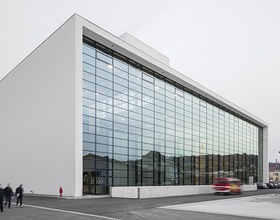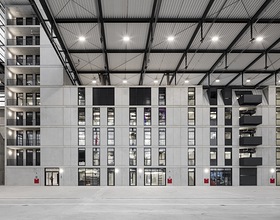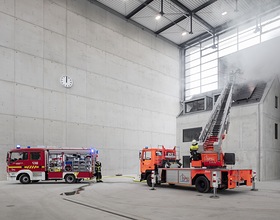STATE FIRE BRIGADE SCHOOL
-
In spite of its size, the design for the new training hall of the State Fire Brigade School in the Würzburg suburb of Zellerau integrates well in the surrounding mixed development area. Seen from the Marienburg historic building, the complex marks a conspicuous point in the urban context. A complex overall appearance is created with the help of two basic building volumes; a high-rise building intersects with the generous glass facades of a larger, horizontal hall building, which measures 77 x 40 x 21 meters. The uniformly whiterendered side elevations of the hall and roof seem to lay a metaphorical bracket around the high-rise building and the hall. The glass facades of the training hall admit generous amounts of daylight to the interior, and also provide access via integrated lifting gates. During the day the new building reflects its surroundings, while at night the interior lighting radiates outwards, offering a view of its sophisticated loadbearing structure, which is also used for training purposes.
Spread over ten levels of the building with its 5,500 square meters of floor area, there are installations for the realistic simulation of extinguishing and rescue operations, technical support activities, or ABC deployments. Using the windows and rooms of the solid, fair-faced concrete training structure inside the hall, it is possible to enact scenarios for deployment in high-rise buildings, restaurants, hotel and office premises, at shops, in a hospital, or a medical practice – situations with different degrees of difficulty which have to be faced by the Fire Brigade on a daily basis.
In the northern part of the hall, a single-family house with tiled double-pitched roof and dormer windows provides the opportunity to practice the placement and scaling of ladders, while on the outside of the hall, the trainees are prepared for the challenges of a multi-story facade fire. On this side of the hall, the actual training structure penetrates conspicuously through the glass facade. In contrast to the strict pattern of the inside facade, the outside elevation has been designed in a more random fashion – window openings of different types are placed in a seemingly accidental pattern, representing additional deployment situations. Slanted prefabricated fair-faced concrete components simulate a mandatory mansard roof, without trivializing the abstract design of the otherwise austere facade.
On the west side of the hall there is a haulage company with rail siding, an HGV garage with delivery ramp, and a high-bay warehouse. The space is rounded off with a building pit which can be covered, and with areas for “technical help” and “hazardous substances” training. The basement floor houses an underground car park, a cellar which can be flooded, a walk-in sewer system, and cellar spaces for additional training purposes. Mobile platforms have been installed on the roof of the hall to provide scenarios for the placement and scaling of ladders. Photovoltaic elements have been installed on the main roof to reduce energy consumption, and a 200 cubic meter cistern has been provided to collect rainwater for extinguishing exercises.
Photo credits: Marcus Bredt
1870 Projects












